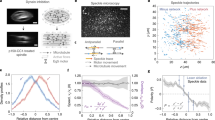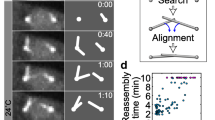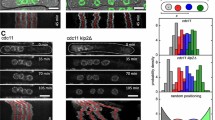Abstract
Cell division mechanisms in eukaryotes and prokaryotes have until recently been seen as being widely different. However, pole-to-pole oscillations of proteins like MinE in prokaryotes are now known to determine the division plane. These protein waves arise through spontaneous pattern forming reaction—diffusion mechanisms, based on cooperative binding of the proteins to a quasistationary matrix (like the cell membrane or DNA). Rather than waves, stationary bipolar pattern formation may arise as well. Some of the involved proteins have eukaryotic homologs (e.g. FtsZ and tubulin), pointing to a possible ancient shared mechanism. Tubulin polymerizes to microtubules in the spindle. Mitotic microtubules are in a highly dynamical state, frequently undergoing rapid shortening (catastrophe), and fragments formed from the microtubule ends are inferred to enhance the destabilization. Here, we show that cooperative binding of such fragments to microtubules may set up a similar pattern forming mechanism as seen in prokaryotes. The result is a spontaneously formed, well controllable, bipolar state of microtubule dynamics in the cell, which may contribute to defining the bipolar spindle.
Similar content being viewed by others
References
Berns, M.W. and Richardson, S.M.: Continuation of Mitosis after Selective Laser Microbeam Destruction of the Centriolar Region, J. Cell Biol. 75 (1977), 977–982.
Bolterauer, H., Limbach, H.-J. and Tuszynski, J.A.: Models of Assembly and Disassembly of Individual Microtubules: Stochastic and Averaged Equations, J. Biol. Phys. 25 (1999), 1–22.
Bornens, M., Paintrand, M. and Celati, C.: The Cortical Microfilament System of Lymphoblasts Displays a Periodic Oscillatory Activity in the Absence of Microtubules: Implication for Cell Polarity, J. Cell Biol. 109 (1989), 1071–1083.
Bucciarelli, E., Giansanti, M.G., Bonaccorsi, S. and Gatti, M.: Spindle Assembly and Cytokinesis in the Absence of Chromosomes during Drosophila Male Meiosis, J. Cell Biol. 160 (2003), 993–999.
Caplow, M. and Shanks, J.: Mechanism for Oscillatory Assembly of Microtubules, J. Biol. Chem. 265 (1990), 1414–1418.
Caplow, M. and Shanks, J.: Induction of Microtubule Catastrophe by Formation of Tubulin-GDP and Apotubulin Subunits at Microtubule Ends, Biochemistry 34 (1995), 15732–15741.
Carballido-López, R. and Errington, J.: A Dynamical Bacterial Cytoskeleton, Trends Cell Biol. 13 (2003), 577–583.
Carlier, M.F., Melki, R., Pantaloni, D., Hill, T.L. and Chen, Y.: Synchronous Oscillations in Microtubule Polymerization, Proc. Natl. Acad. Sci. U.S.A. 84 (1987), 5257–5261.
Carvalho, P., Tirnauer, J.S. and Pellman, D.: Surfing on Microtubule Ends, Trends Cell Biol. 13 (2003), 229–237.
Cassimiris, L.: The Oncoprotein 18/Stathmin Family of Microtubule Destabilizers, Curr. Opin. Cell Biol. 14 (2002), 18–24.
Caudron, N., Valiron, O., Usson, Y., Valiron, P. and Job, D.: A Reassessment of Factors Affecting Microtubule Assembly and Disassembly In Vitro, J. Mol. Biol. 297 (2000), 211–220.
Dechant, R. and Glotzer, M.: Centrosome Separation and Central Spindle Assembly Act in Redundant Pathways that Regulate Microtubule Density and Trigger Cleavage Furrow Formation, Dev. Cell 4 (2003), 333–344.
DeKepper, P., Castets, V., Dulos, E. and Boissonade, J.: Turing-Type Chemical Patterns in the Chlorite-Iodide-Malonic Acid Reaction, Physica D 49 (1991), 161–169.
Desay, A. and Mitchison, T.J.: Microtubule Polymerization Dynamics, Annu. Rev. Cell Dev. Biol. 13 (1997), 83–117.
Ebersbach, G. and Gerdes, K.: The Double par Locus of Virulence Factor p{B}171: DNA Segregation is Correlated with Oscillation of ParA, Proc. Natl. Acad. Sci. U.S.A. 98 (2001), 15078–15083.
Erickson, H.P.: Evolution in Bacteria, Nature 413 (2001), 30.
Gard, D.V. and Kirschner, M.W.: Microtubule Assembly in Cytoplasmic Extracts of Xenopus Oocytes and Eggs, J. Cell Biol. 105 (1987), 2191–2201.
Gital, Z. and Shapiro, L.: Bacterial Cell Division Spirals into Control, Proc. Natl. Acad. Sci. U.S.A. 100 (2003), 7423–7424.
Guyader, H.L. and Hyver, C.: Periodic Activity of the Cortical Cytoskeleton of the Lymphoblast: Modelling by a Reaction–Diffusion System, C. R. Acad. Sci. Life Sci. 320 (1997), 59–65.
Hale, C.A., Meinhardt, H. and deBoer, P.A.J.: Dynamical Localization Cycle of the Cell Division Regulator MinE in Eschericia coli, EMBO J. 20 (2001), 1563–1572.
Hartman, J.J. and Vale, R.D.: Microtubule Disassembly by ATP-Dependant Oligomerization of the AAA Enzyme Katanin, Science 286 (1999), 782–785.
Howard, J. and Hyman, A.A.: Dynamics and Mechanics of the Microtubule Plus End, Nature 422 (2003), 753–758.
Howard, M. and Rutenberg, A.D.: Pattern Formation inside Bacteria: Fluctuations due to the Low Copy Number of Proteins, Phys. Rev. Lett. 90(128102) (2003), 1–4.
Howard, W.D. and Timasheff, S.N.: GDP State of Tubulin: Stabilization of Double Rings, Biochemistry 25 (1986), 8292–8300.
Hu, Z. and Lutkenhaus, J.: Topological Regulation of Cell Division in Eschericia coli Involves Rapid Pole to Pole Oscillation of the Division Inhibitor {M}in{C} Under the Control of MinD and MinE, Mol. Microbiol. 34 (1999), 82–90.
Hunding, A.: Dissipative Structures in Reaction–Diffusion Systems: Numerical Determination of Bifurcations in the Sphere, J. Chem. Phys. 72 (1980), 5241–5248.
Hunding, A.: Spontaneous Biological Pattern Formation in the Three-dimensional Sphere. Prepatterns in Mitosis and Cytokinesis, in H. Haken (ed.) Evolution of Order and Chaos in Physics, Chemistry and Biology. Vol. 17: Springer Series on Synergetics, Springer, Berlin Heidelberg, 1982, pp. 100–111.
Hunding, A.: Bifurcations of Nonlinear Reaction–Diffusion Systems in Prolate Spheroids, J. Math. Biol. 17 (1983), 223–239.
Hunding, A., Ebersbach, G. and Gerdes, K.: A Mechanism for ParB-Dependent Waves of ParA, a Protein Related to DNA Segregation During Cell Division in Prokaryotes, J. Mol. Biol. 329 (2003), 35–43.
Hunding, A. and Engelhardt, R.: Early Biological Morphogenesis and Nonlinear Dynamics, J. Theor. Biol. 173 (1995), 401–413.
Hunter, A.W., Caplow, M., Coy, D.L., Hancock, W.O., Diez, S., Wordeman, L. and Howard, J.: The Kinesin-Related Protein {MCAK} is a Microtubule Depolymerase that Forms an {ATP}-Hydrolyzing Complex at Microtubule Ends, Mol. Cell 11 (2003), 445–457.
Hyman, A.A.: Centrosomes: Sic transit gloria centri, Curr. Biol. 10 (2000), R276–R278.
Job, D., Valiron, O. and Oakley, B.: Microtubule Nucleation, Curr. Opin. Cell Biol. 15 (2003), 111–117.
Jobs, E., Wolf, D.E. and Flyvbjerg, H.: Modeling Microtubule Oscillations, Phys. Rev. Lett. 79 (1997), 519–522.
Jones, L.J.F., Carbadillo-López, R. and Errington, J.: Control of Cell Shape in Bacteria: Helical, Actin-Like Filaments in Bacillus subtilis, Cell 104 (2001), 913–922.
Karsenti, E. and Vernon, I.: The Mitotic Spindle: A Self-Made Machine, Science 294 (2001), 543–547.
Khodjakov, A., Cole, R.W., Oakley, B.E. and Rieder, C.L.: Centrosome-Independent Mitotic Spindle Formation in Vertebrates, Curr. Biol. 10 (2000), 59–67.
Kinoshita, K., Arnal, I., Desai, A., Dreschel, D.N. and Hyman, A.A.: Reconstitution of Physiological Microtubule Dynamics Using Purified Components, Science 294 (2001), 1340–1343.
Kinoshita, K., Arnal, I., Desai, A., Dreschel, D.N. and Hyman, A.A.: Reconstitution of Physiological Microtubule Dynamics Using Purified Components, Science 294 (2001), 1340-1343.
Lupas, A.N. and Martin, J.: AAA Proteins, Curr. Opin. Struct. Biol. 12 (2002), 746–753.
Mandelkow, E., Mandelkow, E.-M., Hotani, H., Hess, B. and Müller, S.C.: Spatial Patterns from Oscillating Microtubules, Science 246 (1989), 1291–1293.
Mandelkow, E.-M. and Mandelkow, E.: Microtubule Oscillations, Cell Motil. Cytoskel. 22 (1992), 235–244.
Mandelkow, E.-M., Mandelkow, E. and Milligan, R.A.: Microtubule Dynamics and Microtubule Caps: A Time-Resolved Cryo-Electron Microscopy Study, J. Cell Biol. 114 (1991), 977–991.
Marston, A.L. and Errington, J.: Dynamic Movement of the ParA-like Soj Protein of B. subtilis and its Dual Role in Nucleoid Organization and Developmental Regulation, Mol. Cell 4 (1999), 673–682.
Marx, A. and Mandelkow, E.: A Model of Microtubule Oscillations, Eur. Biophys. J. 22 (1994), 405–421.
Meinhardt, H.: The Algorithmic Beauty of Sea Shells, Springer, Berlin Heidelberg, 1995.
Meinhardt, H.: The Algorithmic Beauty of Sea Shells, Springer, Berlin Heidelberg, 1995.
Melki, R., Carlier, M.-F., Pantaloni, D. and Timasheff, S.N.: Cold Depolymerization of Microtubules to Double Rings: Geometric Stabilization of Assemblies, Biochemistry 28 (1989), 9143–9152.
Mitchison, T.J. and Kirshner, M.W.: Dynamic Instability of Microtubule Growth, Nature 312 (1984), 237–242.
Mitchison, T.J. and Salmon, E.D.: Mitosis: A History of Division, Nature Cell Biol. 3 (2001), E17–E21.
Mitchison, T.J. and Salmon, E.D.: Mitosis: A History of Division, Nature Cell Biol. 3 (2001), E17–E21.
Moores, C.A., Yu, M., Guo, J., Beraud, C., Sakowicz, R. and Milligan, R.A.: A Mechanism for Microtubule Depolymerization by {K}in{I} Kinesins, Mol. Cell 9 (2002), 903–909.
Narumia, S. and Mabuchi, I.: Spinning Actin to Divide, Nature 419 (2002), 27–28.
G. Nicolis I. Prigogine (1977) Self-Organization in Nonequilibrium Systems Wiley New York
Nicolis, G. and Prigogine, I.: Self-Organization in Nonequilibrium Systems. New York: Wiley, 1977.
Ogura, T. and Wilkinson, A.J.: AAA+ Superfamily ATPases: Common Structure-Diverse Function, Genes Cell 6 (2001), 575–597.
Panda, D., Miller, H.P. and Wilson, L.: Determination of the Size and Chemical Nature of the Stabilizing “Cap’’ at Microtubule Ends Using Modulators of Polymerization Dynamics, Biochemistry 41 (2002), 1609–1617.
Pelham, R.J. and Chang, F.: Actin Dynamics in the Contractile Ring During Cytokinesis in Fission Yeast, Nature 419 (2002), 82–86.
Pirollet, F., Job, D., Margolis, R.L. and Garel, J.: An Oscillatory Mode for Microtubule Assembly, EMBO J. 6 (1987), 3247–3252.
Pletjushkina, O.J., Rajfur, Z., Pomorski, P., Oliver, T.N., Vasiliev, J.M. and Jacobson, K.A.: Induction of Cortical Oscillations in Spreading Cells by Depolymerization of Microtubules, Cell Motil. Cytoskel. 48 (2001), 235–244.
Portet, S., Tuszynski, J.A., Dixon, J.M. and Sataric, M.V.: Models of Spatial and Orientational Self-Organization of Microtubules Under the Influence of Gravitational Fields, Phys. Rev. E 68(021903) (2003), 1–9.
Quarmby, L.: Cellular Samurai: Katanin and the Severing of Microtubules, J. Cell Sci. 113 (2000), 2821–2827.
Quisel, J.D., Lin, D.C.-H. and Grossman, A.D.: Control of Development by Altered Localization of a Transcription Factor in B. subtilis, Mol. Cell 4 (1999), 665–672.
Raskin, D.M. and de Boer, P.A.J.: Rapid Pole-to-Pole Oscillation of a Protein Required for Directing Division to the Middle of Eschericia coli, Proc. Natl. Acad. Sci. U.S.A. 96 (1999), 4971–4976.
Rodriguez, O.C., Schaefer, A.W., Mandato, C.A., Forscher, P., Bement, W.M. and Waterman-Storer, C.M.: Conserved Microtubule-Actin Interactions in Cell Movement and Morphogenesis, Nature Cell Biol. 5 (2003), 599–609.
Rudovics, B., Dulos, E. and DeKepper, P.: Standard and Nonstandard Turing Patterns and Waves in the CIMA Reaction, Physica Scripta T67 (1996), 43–50.
Rusan, N.M., Fagerstrom, C.F., Yvon, A.-M.C. and Wadsworth, P.: Cell Cycle-Dependent Changes in Microtubule Dynamics in Living Cells Expressing Green Fluorescent Protein-α Tubulin, Mol. Biol. Cell 12 (2001), 971–980.
Salmon, E.D., Saxton, W.M., Leslie, R.J., Karow, M.L. and McIntosh, J.R.: Diffusion Coefficient of Fluorescein-Labeled Tubulin in the Cytoplasm of Embryonic Cells of a Sea Urchin: Video Image Analysis of Fluorescence Redistribution after Photobleaching, J. Cell Biol. 99 (1984), 2157–2164.
Scheffers, D.-J. and Driessen, A.J.M.: The Polymerization Mechanism of the Bacterial Cell Division Protein FtsZ, FEBS lett. 506 (2001), 6–10.
Sel’kov, E.E.: Self-Oscillations in Glycolysis, Eur. J. Biochem. 4 (1968), 79–86.
Sept, D.: Model for Spatial Microtubule Oscillations, Phys. Rev. E 60 (1999), 838–841.
Sept, D., Limbach, H.J., Bolterauer, H., and Tuszynski, J.A.: A Chemical Kinetics Model for Microtubule Oscillations, J. Theor. Biol. 197 (1999), 77–88.
Sept, D. and Tuszynski, J.A.: A Landau-Ginsburg Model of the Co-existence of Free Tubulin and Assembled Microtubules in Nucleation and Oscillations Phenomena, J. Biol. Phys. 26 (2000), 5–15.
Shih, Y.-L., Le, T. and Rothfield, L.: Division Site Selection in Escherichia coli Involves Dynamic Redistribution of Min Proteins within Coiled Structures that Extend Between the Two Cell Poles, Proc. Natl. Acad. Sci. U.S.A. 100 (2003), 7865–7870.
Tabony, J.: Morphological Bifurcations Involving Reaction–Diffusion Processes During Microtubule Formation, Science 264 (1994), 245–248.
Tabony, J., Glade, N., Demongeot, J. and Papaseit, C.: Biological Self-Organization by Way of Microtubule Reaction–Diffusion Processes, Langmuir 18 (2002), 7196–7207.
Tabony, J. and Job, D.: Spatial Structures in Microtubular Solutions Requiring a Sustained Energy Source, Nature 346 (1990), 448–451.
Tran, P.T., Joshi, P. and Salmon, E.D.: How Tubulin Subunits are Lost from the Shortening Ends of Microtubules, J. Struct. Biol. 118 (1997), 107–118.
Turing, A.M.: The Chemical Basis of Morphogenesis, Phil. Trans. Roy. Soc. London, Ser. B 237 (1952), 37–255.
Vale, R.D.: AAA Proteins: Lords of the Ring, J. Cell Biol. 150 (2000), F13–F19.
Valiron, O., Caudron, N. and Job, D.: Microtubule Dynamics, Cell. Mol. Life Sci. 58 (2001), 2069–2084.
van den Ent, F., Amos, L.A. and Löwe, J.: Prokaryotic Origin of the Actin Cytoskeleton, Nature 413 (2001), 39–44.
Vandecandelaere, A., Martin, S.R. and Bayley, P.M.: Regulation of Microtubule Dynamic Instability by Tubulin-GDP, Biochemistry 34 (1995), 1332–1343.
Walczak, C.E.: Microtubule Dynamics and Tubulin Interacting Proteins, Curr. Opin. Cell Biol. 12 (2000), 52–56.
Wang, Y.L.: The Mechanism of Cytokinesis: Reconsideration and Reconciliation, Cell Struct. Func. 26 (2001), 633–638.
Watts, N.R., Sackett, D.L., Ward, R.D., Miller, M.W., Wingfield, P.T., Stahl, S.S. and Steven, A.C.: HIV-1 Rev Depolymerizes Microtubules to Form Stable Bilayered Rings, J. Cell Biol. 150 (2000), 349–360.
Wilson, L., Panda, D. and Jordan, M.A.: Modulation of Microtubule Dynamics by Drugs: A Paradigm for the Action of Cellular Regulators, Cell Struct. Func. 24 (1999), 329–335.
Zhou, B.-B. and Kirschner, M.W.: Quantitative Measurements of the Catastrophe Rate of Dynamic Microtubules, Cell Motil. Cytoskel. 43 (1999), 43–51.
Author information
Authors and Affiliations
Corresponding author
Rights and permissions
About this article
Cite this article
Hunding, A. Microtubule Dynamics may Embody a Stationary Bipolarity Forming Mechanism Related to the Prokaryotic Division Site Mechanism (Pole-to-Pole Oscillations). J Biol Phys 30, 325–344 (2004). https://doi.org/10.1007/s10867-004-3387-7
Issue Date:
DOI: https://doi.org/10.1007/s10867-004-3387-7




